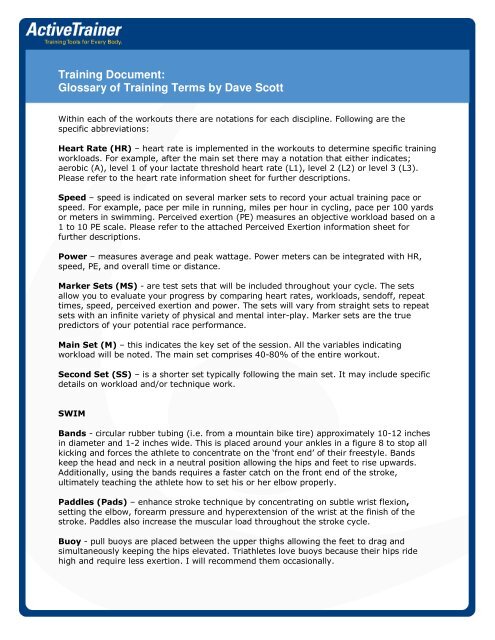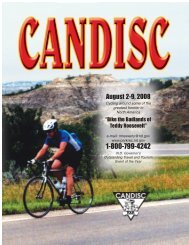Training Document: Glossary of Training Terms by ... - Active.com
Training Document: Glossary of Training Terms by ... - Active.com
Training Document: Glossary of Training Terms by ... - Active.com
You also want an ePaper? Increase the reach of your titles
YUMPU automatically turns print PDFs into web optimized ePapers that Google loves.
<strong>Training</strong> <strong>Document</strong>:<br />
<strong>Glossary</strong> <strong>of</strong> <strong>Training</strong> <strong>Terms</strong> <strong>by</strong> Dave Scott<br />
Within each <strong>of</strong> the workouts there are notations for each discipline. Following are the<br />
specific abbreviations:<br />
Heart Rate (HR) – heart rate is implemented in the workouts to determine specific training<br />
workloads. For example, after the main set there may a notation that either indicates;<br />
aerobic (A), level 1 <strong>of</strong> your lactate threshold heart rate (L1), level 2 (L2) or level 3 (L3).<br />
Please refer to the heart rate information sheet for further descriptions.<br />
Speed – speed is indicated on several marker sets to record your actual training pace or<br />
speed. For example, pace per mile in running, miles per hour in cycling, pace per 100 yards<br />
or meters in swimming. Perceived exertion (PE) measures an objective workload based on a<br />
1 to 10 PE scale. Please refer to the attached Perceived Exertion information sheet for<br />
further descriptions.<br />
Power – measures average and peak wattage. Power meters can be integrated with HR,<br />
speed, PE, and overall time or distance.<br />
Marker Sets (MS) - are test sets that will be included throughout your cycle. The sets<br />
allow you to evaluate your progress <strong>by</strong> <strong>com</strong>paring heart rates, workloads, send<strong>of</strong>f, repeat<br />
times, speed, perceived exertion and power. The sets will vary from straight sets to repeat<br />
sets with an infinite variety <strong>of</strong> physical and mental inter-play. Marker sets are the true<br />
predictors <strong>of</strong> your potential race performance.<br />
Main Set (M) – this indicates the key set <strong>of</strong> the session. All the variables indicating<br />
workload will be noted. The main set <strong>com</strong>prises 40-80% <strong>of</strong> the entire workout.<br />
Second Set (SS) – is a shorter set typically following the main set. It may include specific<br />
details on workload and/or technique work.<br />
SWIM<br />
Bands - circular rubber tubing (i.e. from a mountain bike tire) approximately 10-12 inches<br />
in diameter and 1-2 inches wide. This is placed around your ankles in a figure 8 to stop all<br />
kicking and forces the athlete to concentrate on the ‘front end’ <strong>of</strong> their freestyle. Bands<br />
keep the head and neck in a neutral position allowing the hips and feet to rise upwards.<br />
Additionally, using the bands requires a faster catch on the front end <strong>of</strong> the stroke,<br />
ultimately teaching the athlete how to set his or her elbow properly.<br />
Paddles (Pads) – enhance stroke technique <strong>by</strong> concentrating on subtle wrist flexion,<br />
setting the elbow, forearm pressure and hyperextension <strong>of</strong> the wrist at the finish <strong>of</strong> the<br />
stroke. Paddles also increase the muscular load throughout the stroke cycle.<br />
Buoy - pull buoys are placed between the upper thighs allowing the feet to drag and<br />
simultaneously keeping the hips elevated. Triathletes love buoys because their hips ride<br />
high and require less exertion. I will re<strong>com</strong>mend them occasionally.




